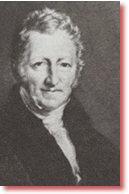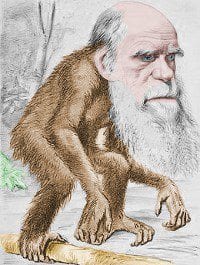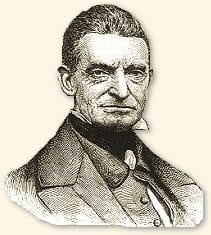The neo-Darwinist model, which we shall take as the mainstream theory of evolution today, argues that life has evolved through two natural mechanisms: natural selection and mutation. The theory basically asserts that natural selection and mutation are two complementary mechanisms. The origin of evolutionary modifications lies in random mutations that take place in the genetic structures of living things. The traits brought about by mutations are selected by the mechanism of natural selection, and by this means living things evolve. However, when we look further into this theory, we find that there is no such evolutionary mechanism. Neither natural selection nor mutations can cause different species to evolve into one another, and the claim that they can is completely unfounded.
The concept of natural selection was the basis of Darwinism. This assertion is stressed even in the title of the book in which Darwin proposed his theory: The Origin of Species, by means of Natural Selection…
Natural selection is based on the assumption that in nature there is a constant struggle for survival. It favors organisms with traits that best enable them to cope with pressures exerted by the environment. At the end of this struggle, the strongest ones, the ones most suited to natural conditions, survive. For example, in a herd of deer under threat from predators, those individuals that can run fastest will naturally survive. As a consequence, the herd of deer will eventually consist of only fast-running individuals.
However, no matter how long this process goes on, it will not transform those deer into another species. The weak deer are eliminated, the strong survive, but, since no alteration in their genetic data takes place, no transformation of a species occurs. Despite the continuous processes of selection, deer continue to exist as deer.
The deer example is true for all species. In any population, natural selection only eliminates those weak, or unsuited individuals who are unable to adapt to the natural conditions in their habitat. It does not produce new species, new genetic information, or new organs. That is, it cannot cause anything to evolve. Darwin, too, accepted this fact, stating that “Natural selection can do nothing until favourable individual differences or variations occur.”7 That is why neo-Darwinism had to add the mutation mechanism as a factor altering genetic information to the concept of natural selection.
We will deal with mutations next. But before proceeding, we need to further examine the concept of natural selection in order to see the contradictions inherent in it.

The essential assumption of the theory of natural selection holds that there is a fierce struggle for survival in nature, and every living thing cares only for itself. At the time Darwin proposed this theory, the ideas of Thomas Malthus, the British classical economist, were an important influence on him. Malthus maintained that human beings were inevitably in a constant struggle for survival, basing his views on the fact that population, and hence the need for food resources, increases geometrically, while food resources themselves increase only arithmetically. The result is that population size is inevitably checked by factors in the environment, such as hunger and disease. Darwin adapted Malthus’s vision of a fierce struggle for survival among human beings to nature at large, and claimed that “natural selection” is a consequence of this struggle.
Further research, however, revealed that there was no struggle for life in nature as Darwin had postulated. As a result of extensive research into animal groups in the 1960s and 1970s, V. C. Wynne-Edwards, a British zoologist, concluded that living things balance their population in an interesting way, which prevents competition for food. Animal groups were simply managing their population on the basis of their food resources. Population was regulated not by elimination of the weak through factors like epidemics or starvation, but by instinctive control mechanisms. In other words, animals controlled their numbers not by fierce competition, as Darwin suggested, but by limiting reproduction.8
Even plants exhibited examples of population control, which invalidated Darwin’s suggestion of selection by means of competition. The botanist A. D. Bradshaw’s observations indicated that during reproduction, plants behaved according to the “density” of the planting, and limited their reproduction if the area was highly populated with plants.9 On the other hand, examples of sacrifice observed in animals such as ants and bees display a model completely opposed to the Darwinist struggle for survival.
In recent years, research has revealed findings regarding self-sacrifice even in bacteria. These living things without brains or nervous systems, totally devoid of any capacity for thought, kill themselves to save other bacteria when they are invaded by viruses.10
These examples surely invalidate the basic assumption of natural selection-the absolute struggle for survival. It is true that there is competition in nature; however, there are clear models of self-sacrifice and solidarity, as well.
Apart from the theoretical weaknesses mentioned above, the theory of evolution by natural selection comes up against a fundamental impasse when faced with concrete scientific findings. The scientific value of a theory must be assessed according to its success or failure in experiment and observation. Evolution by natural selection fails on both counts.
Since Darwin’s time, there has not been a single shred of evidence put forward to show that natural selection causes living things to evolve. Colin Patterson, the senior paleontologist at the British Museum of Natural History in London and a prominent evolutionist, stresses that natural selection has never been observed to have the ability to cause things to evolve:
No one has ever produced a species by the mechanisms of natural selection. No one has ever got near it, and most of the current argument in neo-Darwinism is about this question.11
Pierre-Paul Grassé, a well-known French zoologist and critic of Darwinism, has these words to say in “Evolution and Natural Selection,” a chapter of his book The Evolution of Living Organisms.
The “evolution in action” of J. Huxley and other biologists is simply the observation of demographic facts, local fluctuations of genotypes, geographical distributions. Often the species concerned have remained practically unchanged for hundreds of centuries! Fluctuation as a result of circumstances, with prior modification of the genome, does not imply evolution, and we have tangible proof of this in many panchronic species [i.e. living fossils that remain unchanged for millions of years].12
A close look at a few “observed examples of natural selection” presented by biologists who advocate the theory of evolution, would reveal that, in reality, they do not provide any evidence for evolution.
When evolutionist sources are examined, one inevitably sees that the example of moths in England during the Industrial Revolution is cited as an example of evolution by natural selection. This is put forward as the most concrete example of evolution observed, in textbooks, magazines, and even academic sources. In actuality, though, that example has nothing to do with evolution at all.
Let us first recall what is actually said: According to this account, around the onset of the Industrial Revolution in England, the color of tree barks around Manchester was quite light. Because of this, dark-colored moths resting on those trees could easily be noticed by the birds that fed on them, and therefore they had very little chance of survival. Fifty years later, in woodlands where industrial pollution has killed the lichens, the bark of the trees had darkened, and now the light-colored moths became the most hunted, since they were the most easily noticed. As a result, the proportion of light-colored to dark-colored moths decreased. Evolutionists believe this to be a great piece of evidence for their theory. They take refuge and solace in window-dressing, showing how light-colored moths “evolved” into dark-colored ones.

However, although we believe these facts to be correct, it should be quite clear that they can in no way be used as evidence for the theory of evolution, since no new form arose that had not existed before. Dark colored moths had existed in the moth population before the Industrial Revolution. Only the relative proportions of the existing moth varieties in the population changed. The moths had not acquired a new trait or organ, which would cause “speciation.”13 In order for one moth species to turn into another living species, a bird for example, new additions would have had to be made to its genes. That is, an entirely separate genetic program would have had to be loaded so as to include information about the physical traits of the bird.
This is the answer to be given to the evolutionist story of Industrial Melanism. However, there is a more interesting side to the story: Not just its interpretation, but the story itself is flawed. As molecular biologist Jonathan Wells explains in his book Icons of Evolution, the story of the peppered moths, which is included in every evolutionary biology book and has therefore, become an “icon” in this sense, does not reflect the truth. Wells discusses in his book how Bernard Kettlewell’s experiment, which is known as the “experimental proof” of the story, is actually a scientific scandal. Some basic elements of this scandal are:
- Many experiments conducted after Kettlewell’s revealed that only one type of these moths rested on tree trunks, and all other types preferred to rest beneath small, horizontal branches. Since 1980 it has become clear that peppered moths do not normally rest on tree trunks. In 25 years of fieldwork, many scientists such as Cyril Clarke and Rory Howlett, Michael Majerus, Tony Liebert, and Paul Brakefield concluded that in Kettlewell’s experiment, moths were forced to act atypically, therefore, the test results could not be accepted as scientific.14
- Scientists who tested Kettlewell’s conclusions came up with an even more interesting result: Although the number of light moths would be expected to be larger in the less polluted regions of England, the dark moths there numbered four times as many as the light ones. This meant that there was no correlation between the moth population and the tree trunks as claimed by Kettlewell and repeated by almost all evolutionist sources.
- As the research deepened, the scandal changed dimension: “The moths on tree trunks” photographed by Kettlewell, were actually dead moths. Kettlewell used dead specimens glued or pinned to tree trunks and then photographed them. In truth, there was little chance of taking such a picture as the moths rested not on tree trunks but underneath the leaves.15
These facts were uncovered by the scientific community only in the late 1990s. The collapse of the myth of Industrial Melanism, which had been one of the most treasured subjects in “Introduction to Evolution” courses in universities for decades, greatly disappointed evolutionists. One of them, Jerry Coyne, remarked:
My own reaction resembles the dismay attending my discovery, at the age of six, that it was my father and not Santa who brought the presents on Christmas Eve.16
Thus, “the most famous example of natural selection” was relegated to the trash-heap of history as a scientific scandal-which was inevitable, because natural selection is not an “evolutionary mechanism,” contrary to what evolutionists claim.
In short, natural selection is capable neither of adding a new organ to a living organism, nor of removing one, nor of changing an organism of one species into that of another. The “greatest” evidence put forward since Darwin has been able to go no further than the “industrial melanism” of moths in England.
As we showed at the beginning, the greatest problem for the theory of evolution by natural selection, is that it cannot enable new organs or traits to emerge in living things. Natural selection cannot develop a species’ genetic data; therefore, it cannot be used to account for the emergence of new species. The greatest defender of the theory of punctuated equilibrium, Stephen Jay Gould, refer to this impasse of natural selection as follows;
The essence of Darwinism lies in a single phrase: natural selection is the creative force of evolutionary change. No one denies that selection will play a negative role in eliminating the unfit. Darwinian theories require that it create the fit as well.17
Another of the misleading methods that evolutionists employ on the issue of natural selection is their effort to present this mechanism as an intelligent designer. However, natural selection has no intelligence. It does not possess a will that can decide what is good and what is bad for living things. As a result, natural selection cannot explain biological systems and organs that possess the feature of “irreducible complexity.” These systems and organs are composed of a great number of parts cooperating together, and are of no use if even one of these parts is missing or defective. (For example, the human eye does not function unless it exists with all its components intact).
Therefore, the will that brings all these parts together should be able to foresee the future and aim directly at the advantage that is to be acquired at the final stage. Since natural selection has no consciousness or will, it can do no such thing. This fact, which demolishes the foundations of the theory of evolution, also worried Darwin, who wrote: “If it could be demonstrated that any complex organ existed, which could not possibly have been formed by numerous, successive, slight modifications, my theory would absolutely break down.”18

Mutations are defined as breaks or replacements taking place in the DNA molecule, which is found in the nuclei of the cells of a living organism and which contains all its genetic information. These breaks or replacements are the result of external effects such as radiation or chemical action. Every mutation is an “accident,” and either damages the nucleotides making up the DNA or changes their locations. Most of the time, they cause so much damage and modification that the cell cannot repair them.
Mutation, which evolutionists frequently hide behind, is not a magic wand that transforms living organisms into a more advanced and perfect form. The direct effect of mutations is harmful. The changes effected by mutations can only be like those experienced by people in Hiroshima, Nagasaki, and Chernobyl: that is, death, disability, and freaks of nature…
The reason for this is very simple: DNA has a very complex structure, and random effects can only damage it. Biologist B. G. Ranganathan states:
First, genuine mutations are very rare in nature. Secondly, most mutations are harmful since they are random, rather than orderly changes in the structure of genes;any random change in a highy ordered system will be for the worse, not for the better. For example, if an earthquake were to shake a highly ordered structure such as a building, there would be a random change in the framework of the building, which, in all probability, would not be an improvement.19
Not surprisingly, no useful mutation has been so far observed. All mutations have proved to be harmful. The evolutionist scientist Warren Weaver comments on the report prepared by the Committee on Genetic Effects of Atomic Radiation, which had been formed to investigate mutations that might have been caused by the nuclear weapons used in the Second World War:
Many will be puzzled about the statement that practically all known mutant genes are harmful. For mutations are a necessary part of the process of evolution. How can a good effect-evolution to higher forms of life-result from mutations practically all of which are harmful?20

Every effort put into “generating a useful mutation” has resulted in failure. For decades, evolutionists carried out many experiments to produce mutations in fruit flies, as these insects reproduce very rapidly and so mutations would show up quickly. Generation upon generation of these flies were mutated, yet no useful mutation was ever observed. The evolutionist geneticist Gordon Taylor writes thus:
It is a striking, but not much mentioned fact that, though geneticists have been breeding fruit-flies for sixty years or more in labs all round the world- flies which produce a new generation every eleven days-they have never yet seen the emergence of a new species or even a new enzyme.21

Another researcher, Michael Pitman, comments on the failure of the experiments carried out on fruit flies:
“Morgan, Goldschmidt, Muller, and other geneticists have subjected generations of fruit flies to extreme conditions of heat, cold, light, dark, and treatment by chemicals and radiation. All sorts of mutations, practically all trivial or positively deleterious, have been produced. Man-made evolution? Not really: Few of the geneticists’ monsters could have survived outside the bottles they were bred in. In practice mutants die, are sterile, or tend to revert to the wild type.”22
Continued on next page…



